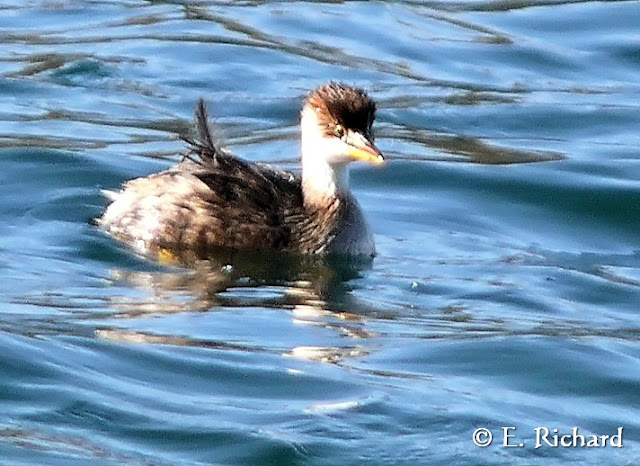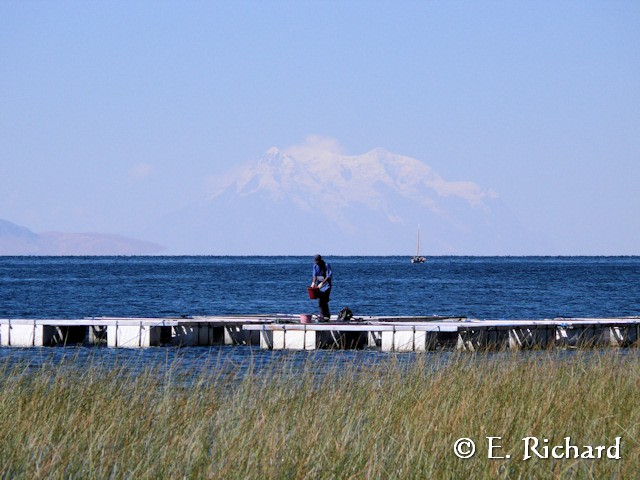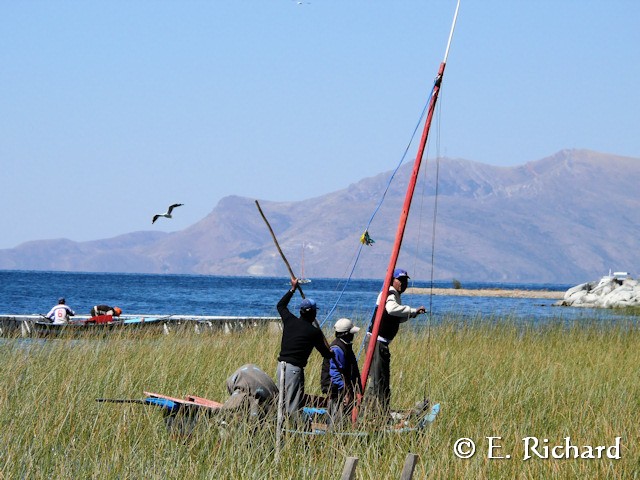San Pedro de Tiquina, June 20, 2010. Lumix FZ 50, Leica zoom from 35 to 420. Crop.
Huiñaymarka The lake is considered by BirdLife International (Devenish et al 2009) as an Area of \u200b\u200bImportant Bird (AICA BO018).
As commented in the previous note in this lake inhabits Kenolaba ( Rollandia microptera ) species with timely distribution and restricted to the reed ( Schoenoplectus californicus Tator ) above 3700 m within the basin of Lake Titicaca Peru Bolivia and Poopó (Oruro, Bolivia). The Kenolaba (Rollandia microptera) is a species of bird of extreme K, ecological gradient r -> K and vulnerability to environmental impacts is therefore directly proportional to its degree of adaptation and specialization K. Diving feeds of local species, especially fish Orestias ispi, O. agassii (vulnerable status MMAyA 2009), O. olivaceus, O. luteus (vulnerable status MMAyA 2009) also endemic to the Lake Titicaca basin (Aranibar and Flores 2009). According to Aranibar and Flores (2009), the diet includes gastropods as Littoridina sp Ramphopoma magnus, Taphius and casually montanus frogs. Its current international conservation status (IUCN 2008) is Endangered (EN) as the recent national categorization (Aranibar and Flores 2009), the fall into the category of Endangered (EN) as well. In the previous note, I denounced the mass mortality of the species and the causal factors attributed to four interrelated, Interspecific competition, fishing from their main food (Orestias spp), reduction of habitat and pollution. Therefore I proposed to change their status to Critically Endangered, a position now strengthened and maintain, and documentation with the addition of two new risk factors, hunting and lack of education ...
contextualized On 20 June 2010 were invited to share a winter evening with friends at the beautiful home of the British writer Margaret Joan Anstee in San Pedro de Tiquina, the largest "island" Huiñaimarka lake and enjoy the warm pool. Before lunch (11:00 pm) I went for a walk along the coast and enjoy the view unbeatable seafront that owns this house.
San Pablo de Tiquina view from the house of Margaret Joan Anstee, in San Pedro de Tiquina. Lumix FZ 50. June 20, 2010.
San Pedro Bay Tiquina. Lumix FZ 50. June 20, 2010.
Huatajata grove in the background and real mountains, view from the dock of the house of Margaret Joan Anstee in San Pedro de Tiquina. Lumix FZ 50. June 20, 2010.
I sat down to enjoy the view from the pier, where a very small and scattered cattails training ( Schoenoplectus californicus Tator), which allows the growth among them of a community of Elodea potamogeton - Miriophyllum elatinoides and Potamogeton sp. And to my great satisfaction I saw, for the outstanding water clarity, ispis ( Orestias ispi) and some k'araches! Wonderful. To make matters worse, left the dock in a huge underwater rocks I saw also the icing on the cake, some sponges ( Balliviaspongia wirrmanni ) green algae by the presence of symbionts. What a privilege to see yet another endemic species in the lake!. The only thing that ruined the view of a farm conservation was trout (Oncorhynchus mikiss ) of neighboring property ...
A wonderful place there is always something to spoil the view ... Trout Hatchery, San Pedro de Tiquina. Lumix FZ 50. June 20, 2010.
After a while of contemplation came to my great pleasure, excitement and immense pleasure two pairs of Kenolaba, what great happiness!. I spent about half an hour watching the hunt and its forays into the lake. An unforgettable spectacle. Unfortunately, showed an unusual distance of flight, so I just barely could watch with my binoculars (12 x 25) ...
And the good never lasts long, appeared to my left a small sailboat, with three community members on board sailing very close to the coast and it caught my attention that when one is dealing with navigation, the other two were standing near the bow with slingshots! Stayed with them the following dialogue:
.- Good morning!
.- (Silence
.- Good morning!
.- (Silence
.- Hey, you on the boat, I am invited for this property and want to know why carry slingshots
.- We will not hunt here
.- Ahhh no? Where?
.- On the property next door
.- What hunt?
.- Kenolaba
Why hunt .- Kenolaba
.- The kill no more
.- Ahhh, I can know why
.- They eat our fish, since almost no at fault ispis
that trout will not eat their crap ispis and Lake shooting kills also
.- Silence ...
I left my bag on the floor, opened to remove the camera and received a piedrazo in the bag, looked up and was shooting with slingshots!. I took refuge behind a rock and prepared my camera, with great impotence, a lot of anger and pain and just understand why the distance of flight of these wonderful animals to avoid fighting, no more and no less than extinction ...
boat hunter (?) of Kenolaba looking for them among the reeds, the community member of the bows pointing his slingshot to waiting for me to go. Lumix FZ 50. June 20, 2010. 11:30 am
community member of the bows pointing his slingshot to waiting for me to go. Trim previous photo. Lumix FZ 50. June 20, 2010.
Kenolaba Looking at the periphery of the reeds. The two couples flaunting Kenolaba Darwinian learning was gone and my heart returned to its place ... Lumix FZ 50. June 20, 2010.
I was a good time with great pain and sorrow for what happened, seeing the boat away to others looking for other Kenolaba cattails ... ... Reflecting on the paradox, these people Kenolaba killing, making them responsible for a problem that is inherently of them (Competition by overfishing, competition from introduced species [trout and mackerel] Kenolaba with the same food resource [ispis], extreme reduction of habitat by removing vegetation serves as habitat for Kenolaba and food, and pollution ... see note above) and the paradox?. The paradox is that later, these same people, pays tribute and respect to the mother of Kenolaba, the reeds and ispis, the Pacha Mama ... no words ...
All
an educational problem, no one loves him not known and what does not love does not keep (Richard and Contreras 2010) ... The colonial education has brought among other consequences, loss of ancestral link with the heritage, leading to paradoxes like the exposed ...
I left quietly and returned depressed to chat with my friends ... and I remembered this scene actually had already seen before, not only related to the Kenolaba but all the birds of the Sacred Lake ...
Later at home, more relaxed and reviewed my field notebook and photographic archive and remember that Cohana Bay , where the reeds and underwater vegetation or llachu ( Miriophyllum elatinoides ) Sacred Lake subsidize irrational and unsustainable beef cattle and sheep that community members raise their costs to the detriment of the mandate of MOTHER inherited them camelid animal husbandry, not only collect reeds but everything associated with them, particularly the spawning of waterfowl ... Let's review my notes ...
Cohana Bay community member, showing products of collection of cattail (duck eggs, chokes, and other Kenolaba eggs found ...). Cohana Bay, December 3, 2003. Polaroid DC 30.
Some of the byproducts of harvesting of the reeds (duck eggs, chokes, and other eggs Kenolaba find foo ... spp) displayed by the former community member. Cohana Bay, December 3, 2003. Polaroid DC 30.
Suriki Island, community member showing the use of trident spear used for hunting waterfowl especially chokes ( Fulica spp.) June 2, 2003. Polaroid DC 30.
Suriki Island, showing comunario trident spear used for hunting waterfowl especially chokes ( Fulica spp.) June 2, 2003. Polaroid DC 30.
Tiwanaku Sunday Market, where every Sunday is sold at half the price of chicken eggs, the eggs collected in Santa Rosa, Pillapi, Huacullani e Suriki Island as a byproduct of the massive removal of cattail ... How many eggs?? An average of 60 - 100 per basket. That day I counted eight vendendoras of eggs, making extraction rate from 480 to 800 eggs on Sunday! The question is ... How long have the birds Kenolaba and Sacred Lake ... to be losing their nests once a week ?
Huacullani, massive extraction of reeds, I reiterate the support, feeding and care of the fishes, birds and invertebrate fauna in general of something sacred ... Why? To feed the sheep and cattle are raised away from the lake ... The lack of respect for the Pacha Mama is seen even in the absence of respect for life. These donkeys are overloaded beyond their means every day until they die ... It would be good that Dr Jennifer Ibarra said something about his subject: Animal Welfare ... Huacullani, April 6, 2003. Polaroid C 30.
What should load these animals every day is unimaginable, only based on the weight of wet reeds ... Huacullani, April 6, 2003. Polaroid C 30.
Afternoon (16:00 pm), and then to remember and reflect on this, I returned to shore with the hope of seeing again the Kenolaba. To my great sorrow, only became a partner ... A beautiful couple, and knowing that predators were no longer reduced the distance of flight, not as I would have liked, but obviously if you made her feel safe ... and that's the main thing, right? Unfortunately the light, very lateral (16:00 am begins the evening at Sacred Lake) was not favorable. But despite the light, I enjoyed watching them hunt and take them some pictures, as could even film a few seconds, now share material, because these animals belong to all, I wish everyone thought like that ...
Kenolaba, looking suspicious about the photographer, obviously wondering if the camera was such and such a weapon ... These animals should see a lot of weapons, few cameras ... San Pedro de Tiquina, June 20, 2010. Lumix FZ 50, Leica zoom from 35 to 420. Crop.
Kenolaba young specimen of shaking its wings after a dive. San Pedro de Tiquina, June 20, 2010. Lumix FZ 50, Leica zoom from 35 to 420. Crop.
same example, after a successful dive and catch a black Karach ( Orestias agassi ), a much larger prey to the usual ispis ( Orestias ispi ). San Pedro de Tiquina, June 20, 2010. Lumix FZ 50, Leica zoom from 35 to 420. Crop.
same example, after a successful dive and catch a black Karach ( Orestias agassi ), a much larger prey to the usual ispis ( Orestias ispi ). San Pedro de Tiquina, June 20, 2010. Lumix FZ 50, Leica zoom from 35 to 420. Crop.
same example, after a successful dive and catch a black Karach ( Orestias agassi ), a much larger prey to the usual ispis ( Orestias ispi ). San Pedro de Tiquina, June 20, 2010. Lumix FZ 50, Leica zoom from 35 to 420. Crop.
The President of the State of Bolivia said
The right to life means the right to exist. The law
to any ecosystem, any species of animal
or plant, no river or lake to be removed or exterminated
by human action "
(Evo Morales - Decalogue 2008)
With all due respect, my view on this is:
Research to know ...
knowledge to manage ...
Educate to keep ...
Store to thrive ...
Because ...
can not want, love, keep ...
what is not known or not want to know if there ...
E. Richard
Failure to do this, what was said by Mr President (which I fully support) is only wishful thinking and nothing more ... It's what happens when what is said and reality are different paths ...
A from what is shared in these notes on Kenolaba, we are currently developing formal work with the ornithologist Horacio Luna and environmental education program that allows awareness about this problem at all circumlacustres priority populations and later Bolivia. Additionally we will develop in different communities Guardambientes circumlacustres course contextualized version of the passed in Argentina by the author. Why is heritage conservation work and commitment of all ... Hopefully this will begin with an alphabet which is taught Kenolaba K instead of K for Koala, which is now taught in many schools ...
The educational process should also include friends the Navy, Titicaca district because the Navy is committed to the sovereignty of Bolivia in the Sacred Lake and sovereignty is not only territory, but what is above and below it, the heritage ... The Kenolaba and biodiversity of the lake then it is part of their responsibility as custodians of heritage and sovereignty and will have to ensure the conviction of the case, for the safety of such biodiversity patrolling and taking appropriate action against unscrupulous hunters, at least until education to allow these hunters to become custodians of the legacy inherited by their ancestors and thereby restore harmony with
MOTHER ...
As stated previously, this beautiful haven for wildlife and biodiversity, including numerous endemic species of different biological groups, whose ajayu, according to the tradition of the people Pukina, Aymara and Quechua is protected by the Pacha Mama, today is at risk ... What? Of losing it forever as a result of a "Pachacidio (fide Barral Zegarra 2009) the result of functional illiteracy. In the absence of contextual education, by and for Bolivia ... In this series, "Chronicle of a Death Foretold, Gabriel García Márquez paraphrase, we will show first hand, all with the hope to reflect on what we do on this amazing place, heritage of all Bolivians and planet. Because you can not manage what you do not know, can not love what you do not know ... and why it is necessary to love? For love is the fundamental and primary input to keep it retains ... Nobody loves no (Richard 2003) ... And why do we keep? Knowing to love, love to keep, keep to thrive ... because you can not prosper, nor think of sustainable development based on the destruction of a finite planet (Richard and Contreras 2010) ... Huinaymarca Because the lake and all its biodiversity is a legacy from our ancestors, our heritage and by definition those who care and love their heritage are patriots ... My question remains: Where are the patriots? ...
ACKNOWLEDGEMENTS
Denise and Melissa tireless traveling companions. Pamela Andrea Vera and other friends of the graduate of the UMSA and Margaret Joan Anstee for the beautiful evening in San Pedro de Tiquina. Horacio Luna to be always present as an ornithologist and above all, as a friend. To all who commented on the note on the subject.
bibliography
ARANIBAR H. and C. PRADO FLORES. 2009. Microptera Rollandia Gould, 1868. Pp 347 to 348. In: Luis F. Aguirre, Rodrigo Aguayo, Jose Balderrama, Claudia Cortez & Teresa Tarifa. Red Book of vertebrate wildlife in Bolivia. Ministry of Environment and Water, La Paz, Bolivia. 571 pp.
BARRAL ZEGARRA, R. 2009. Teaching political emancipation. Ed Gap. Ayni Ruway Community Education. 284 p.
Devenish, C., DÍAZ FERNÁNDEZ, DF, Clay, RP, DAVIDSON, I. & YEPEZ Zabala, I. EDS. (2009) Important Bird Areas Americas - Priority sites for Biodiversity Conservation. Quito, Ecuador: BirdLife International (BirdLife Conservation Series No. 16).
MINISTRY OF ENVIRONMENT AND WATER (MMAyA) 2009. Red Book of vertebrate wildlife in Bolivia. Ministry of Environment and Water, La Paz, Bolivia. 571 pp.
2005. Cohana Bay, Lake Titicaca: A paradise to discover. ROMI + CD Super Video CD (SVCD). Multimedia Theratos Ed. La Paz, Bolivia. DL 4-4-85-04. ISBN 99905-0-454-7.
RICHARD E. and D. CONTRERAS ZAPATA. 2010. Environmental Education for the third millennium. A tribute to Mother Earth. Course notes for training trainers. Multimedia EcoDreams Ed. 366 p. La Paz, Bolivia. Http://www.mediafire.com/file/mgil550nunz/LibroEABeta03_10.pdf
GLOSSARY
Ajayu : Alma, inner spirit. The ajayu is the principal of 'spirits' that man has. Is related to awareness, reasoning and with the life force. Diversified into different 'spirits' that vitalize the human body parts. Most important, called jach'a ajayu *, is in the head, the other, Jisk'a ajayu *, found in other parts of the body, especially in the limbs. Together they are as nerves that communicate. http://www.ucb.edu.bo/aymara/index.php?title=Ajayu. The transcendent Ajayu does not reincarnate, it is or deposited in Akapacha objects (this world or planet earth) or Alaxpacha (eternal space, sky). The Ajayu transcendent is conceived as the element of perfection unlimited.
Choka : Collectively applies to all species of the genus Fulica that inhabit the lake sacred.
Mama Pacha: Pachamama Divinity represents the Earth, not just the floor or ground geological and not only nature, it is all together. Not located in a specific place, but is concentrated in certain places such as springs, streams, or apacheta. But it is an immediate deity and daily, which acts directly by presence and with which the ongoing dialogue, asking them either support or apologizing for any offense committed against the earth and all it provides. There is a divine creator but protectors and providers, shelters for men, enables and promotes life fecundity and fertility. In exchange for aid and protection, the pastor of the Southern Puna is required to make offerings to the Pacha of what we receive, not only at times and predetermined sites for the ritual but, in particular, in all significant cultural events, configuring and a kind of reciprocity. "
Kenolaba video filmed at the opportunity
DOWNLOAD
http://www.mediafire.com/file/zjnmykw12n5/KenolaFLV.flv
Made in Bo liv ia by American ...
Patria Grande For Latin America ...
Made in Bo liv ia by American ...
Patria Grande For Latin America ...






















0 comments:
Post a Comment